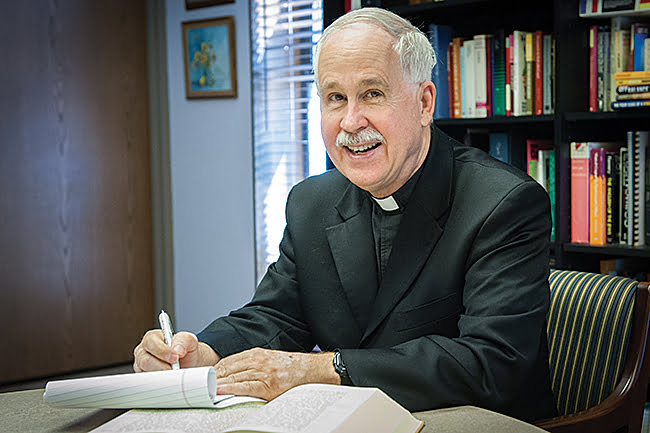
Father Mike Stubbs is the pastor of Holy Cross Parish in Overland Park and has a degree in Scripture from Harvard University.
by Father Mike Stubbs
On Easter Sunday, the vast crowds of people attending Mass make it more difficult than usual to estimate the number of altar breads to set out for consecration during the Eucharist. It is even sometimes necessary to break up the hosts, in order to have a sufficient number for those receiving holy Communion.
By a strange twist of fate, this happened this past Easter Sunday at my parish, just as we were singing the song “At the Breaking of the Bread.” We did not plan that. It just happened that way.
The song refers to the incident described in this Sunday’s Gospel reading, Lk 24:13-35. Two disciples are fleeing the city of Jerusalem. As they are walking on the road to the village of Emmaus, they encounter a stranger, who enters into conversation with them. He explains to them the recent events — specifically, why their master Jesus had to die on the cross. Once they arrive at Emmaus, they stop there for supper. As the stranger breaks the bread, the two disciples realize that he is Jesus, risen from the dead.
All this happened long before the days of sliced bread and before altar breads were manufactured as small, bite-size wafers. When the early Christians celebrated the Eucharist, they would have used a single loaf of bread, which needed to be broken up in order for all to share. This practical necessity acquired a symbolic meaning among them. It represented the unity of the church.
That is why St. Paul writes: “The bread that we break, is it not a participation in the body of Christ? Because the loaf of bread is one, we, though many, are one body, for we all partake of the one loaf” (1 Cor 10: 16-17).
The action of breaking the consecrated bread held such importance in the early church that “the breaking of the bread” was the first term used to refer to the Eucharist.
That is what is meant in this description of the life of the early Christian community in Jerusalem: “They devoted themselves to the teaching of the apostles and to the communal life, to the breaking of the bread and to the prayers” (Acts 2: 42).
Even now, in these days of convenient bite-size wafers for Communion, the priest always breaks the large host in two. This action is not required for practical purposes.
Rather, it hearkens back to the days of the early church. It reminds us that we are still participating in the breaking of the bread, just like the two disciples on the road to Emmaus. That is how we encounter the risen Christ.

